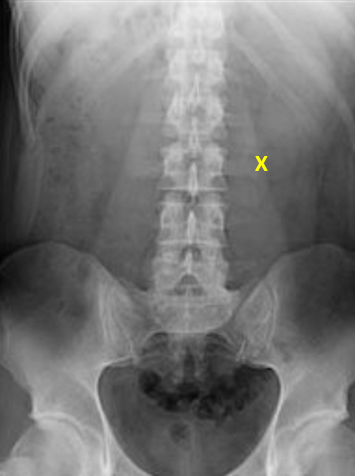Previously, I presented a scenario where a victim of a gunshot to the abdomen was taken to the OR after obtaining the image below. No bullet was seen on the x-ray, and none was found at the time operation.

Where could it have gone? Let’s assume that the surgeon did a good job, and it is not in the abdomen. Any more. There are several possibilities.
Does the x-ray cover the correct area? To cover a straighforward abdominal gunshot, it needs to show diaphragms to perineum, side to side. In these days of “super size me”, that usually doesn’t happen with one image. Look carefully at the one above. It doesn’t show any portion of the diaphragm, and doesn’t go low enough, either. And although the right flank can be seen, the left is cut off. So in this case, the bullet could be in the soft tissues of the torso, in the extraperitoneal rectal area, or near the diaphragm in the liver.
It could have moved outside the area of the initial x-ray. The most common mechanism for this is entry into the vascular system. If it enters the venous system, it will end up in the heart or pulmonary artery somewhere. This will be obvious when you get a chest x-ray. If it enters the aorta, it will embolize into the lower extremities. This fact should be painfully obvious when you check the pulses in the lower extremities.
The patient could poop it out if it entered their GI tract. This could happen if you wait to get additional images of the abdomen. If you bracket it with x-rays immediately, this should not happen.
In theory, the bullet could enter the bladder and get urinated out. This won’t happen if a catheter is in place. And it’s probably unrealistic because most bullets would cause tremendous pain passing, and would probably obstruct the urethra anyway.
Finally, it could have bounced. Never count on this one. Bullets can and do enter partially, then stop or fall out. They can cause underlying perforation of the peritoneum, and they can bruise nearby structures. This is extremely uncommon and should be a diagnosis of last resort!
Bottom line: If patient condition permits, the patient with a gunshot to the abdomen who will be taken to the OR should have any wounds marked and an initial abdominal image obtained that shows the entire abdomen. This may take multiple attempts. The image can be very helpful in directing the exploration and finding wounds. If it is not seen on the initial image(s), check the lower extremity pulses and obtain a chest x-ray to locate the bullet prior to the case.

